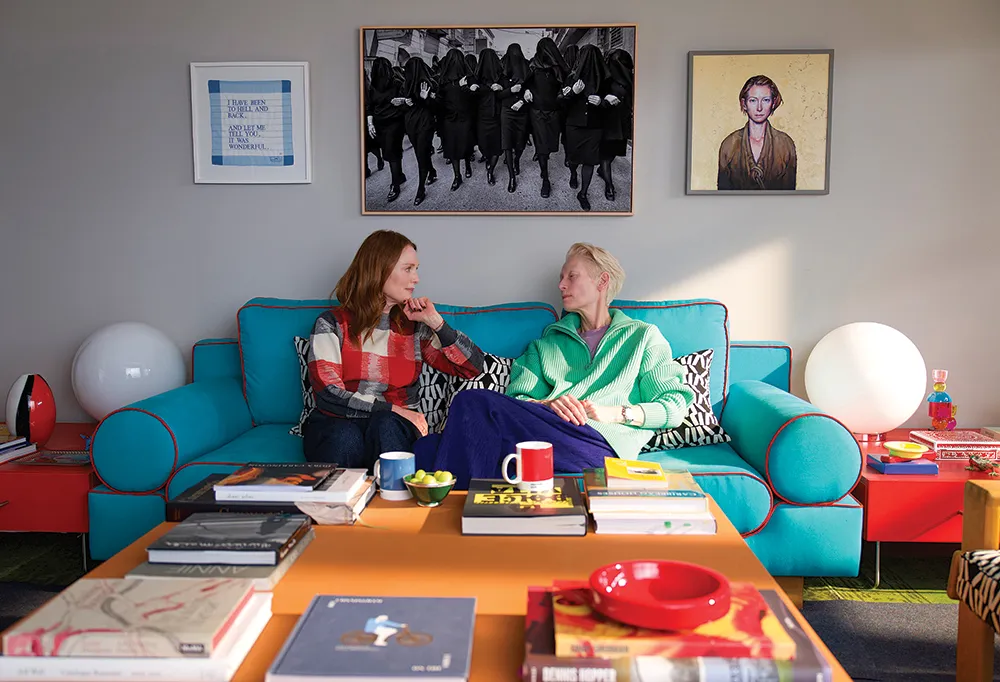After an illustrious career spanning more than four decades and a number of critically acclaimed Spanish-language films, Pedro Almodovar has made his English-language film debut with his latest film, “The Room Next Door.” Based on the novel by Sigrid Nunez, the film is Almodovar’s first foray into English filmmaking and showcases his particular talent, exploring themes of aging and death from a deeply personal perspective. Starring Julianne Moore and Tilda Swinton, the film has garnered attention not only for its talented lead characters but also for its unique blend of Almodovar’s vibrant style and more restrained narrative approach.
A New Chapter in Almodovar’s Career
Known for his bold visual style and emotionally charged storytelling, Pedro Almodovar has made a significant transition with “The Room Next Door.” His first film in English, the film is a heartwarming exploration of aging, friendship, and the complexities of life and death. Almodóvar’s move into English-language cinema may surprise some fans, but it’s clear that the director has infused his distinctive artistic vision into the film, even as it navigates a new linguistic and cultural landscape.

Plot and Characters: A Tale of Friendship and Death
“The Room Next Door” centers on two former friends, Ingrid (Julianne Moore) and Martha (Tilda Swinton), who reunite under tragic circumstances. Ingrid, a successful writer struggling with her fear of death, learns that Martha, a once-war reporter, is battling fatal cancer. Their reunion, initially marked by nostalgia and reconnecting, soon takes a darker turn when Martha requests Ingrid’s presence during her planned euthanasia.
The film unfolds with an intimate focus on these two characters, as their relationship evolves from a simple reconnection into a deeply poignant exploration of friendship and the end of life. Almodóvar’s direction ensures that the film’s main themes of mortality and the human condition are explored with sensitivity and depth, even if the narrative sometimes falters in its dialogue and pacing.
Acting: Julianne Moore and Tilda Swinton Shine
Julianne Moore and Tilda Swinton deliver fine performances that carry the film forward. Moore, known for her ability to convey intense emotional depth, brings an intense and poignant quality to Ingrid. Her portrayal is both poignant and unsettling, reflecting the complexity of a character facing profound existential fears.

Swinton’s performance as Martha is equally compelling. Her portrayal of a woman who faces the end of her life with both defiance and vulnerability is a testament to her range and skill as an actress. Together, Moore and Swinton form a dynamic and emotionally charged partnership that drives the film’s narrative forward.
Almodóvar’s signature style meets new territory
While “The Room Next Door” is Almodóvar’s first English-language film, it is undoubtedly his work to date. The film’s use of vibrant colors, lush cinematography, and intricate set design reflect Almodóvar’s signature visual style. However, the film also explores a more restrained and introspective tone, a departure from the glitz and glamour of his previous Spanish-language films.
Almodóvar’s choice to film in New York, with its backdrop of urban landscapes and harsh interiors, contrasts starkly with the rich and warm settings of his earlier works. This shift highlights the film’s thematic exploration of death and old age, as the characters move from the bustling city to a quiet, yet gloomy, retreat in the mountains.
Reception and criticism: A mixed bag
Upon its premiere, “The Room Next Door” received a mixed reception from critics. While some praised the film’s emotional depth and the performances of Moore and Swinton, others found the dialogue and pacing lacking. The film’s shift from a harsh, urban setting to a quiet mountain retreat was seen by some as a strength, offering a poignant contrast to the drama of the story’s unfolding.

Despite some criticism, the film’s exploration of age and death was praised for its honest and heartfelt approach. Almodóvar’s ability to mix humor with serious themes is evident, although the film’s more action-packed moments and slow pace may not appeal to all viewers.
Themes and Reflections: Aging and Happiness in the Face of Death
At its core, “The Room Next Door” is a reflection on aging and the human experience. Almodóvar’s exploration of these themes is both tender and thought-provoking. The film’s depiction of the end of life is not only a personal journey for Ingrid and Martha, but it is also a broader commentary on how we face our own mortality.
The film depicts old age as a source of both wisdom and vulnerability, which is a testament to Almodóvar’s ability to handle complex emotional themes. The narrative challenges traditional notions of old age, presenting characters who face their fears with both complacency and defiance.

